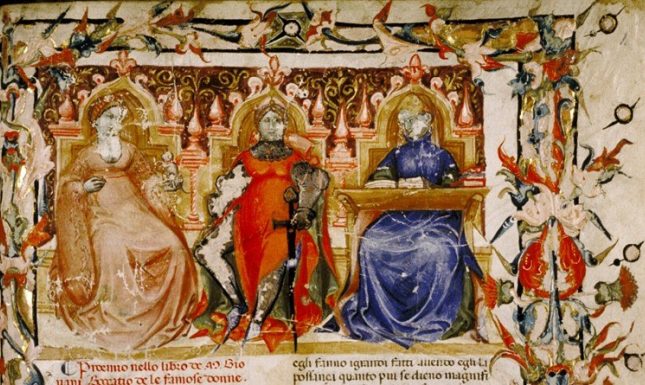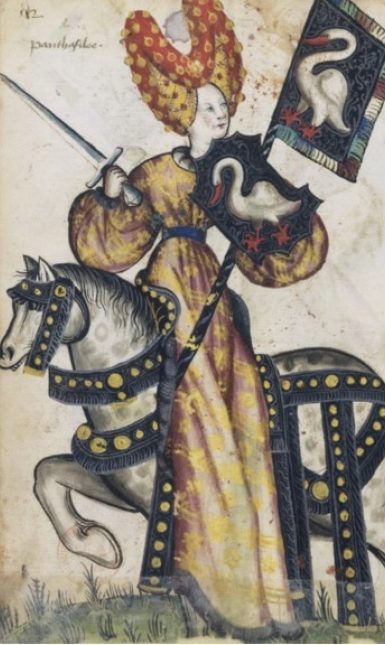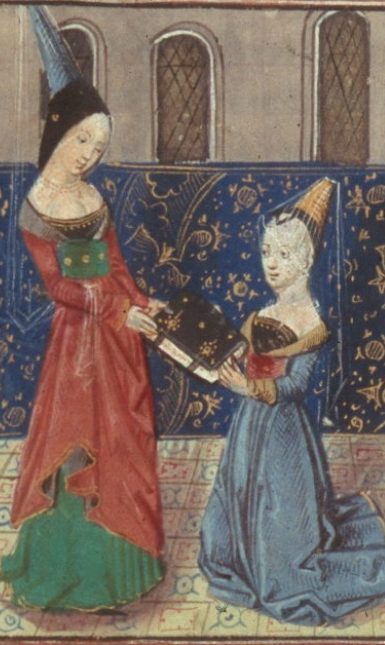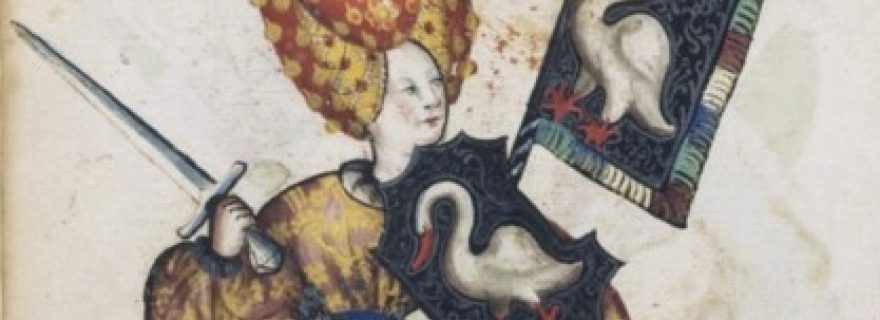Pious women and warrior queens. Female role models in the late medieval period
Medieval women were considered unfit for public tasks such as governance and warfare. Nonetheless, many princesses wielded power, as a result of their dynastic position and personal ambition. Female role models of the late medieval period seem to reflect the ambiguity of their position.
Nine Worthies
Since the beginning of the fourteenth century, the ‘Nine Worthies’ functioned as role models for medieval princes. Three of them were pagan (Hector, Alexander the Great and Julius Caesar), three were Jewish (Joshua, David and Judas Maccabeus) and the final three were Christian rulers (King Arthur, Charles the Great and Godfrey of Bouillon). Together, they represented a generally accepted image of the ideal, chivalrous prince. But who were their female counterparts? Although lists of ‘Nine Worthy Women’ existed, their composition varied. So how did a medieval princess choose a role model to identify herself with?
The question came up when I was looking into a relatively unknown laudatory poem in praise of Margaret of Burgundy, former countess of Hainault, Holland and Zeeland, probably written around 1420. After Margaret’s husband, the Count of Holland died in 1417, she had to fight many battles in order to safeguard the position of her only child, Jacqueline of Bavaria, as his successor.
In the poem, Margaret’s virtues are compared to those of three famous women, known from ancient Greek and Roman history and mythology: Penthesilea, Dido and Medea. The anonymous poet states that he cannot truly compare these ladies to Margaret of Burgundy 'since they have physical strength, but she has spiritual strength, like all her predecessors, who were true servants of God’. But he tells us that he has been advised, presumably by Margaret herself or someone close to her, that a comparison with these three heroines is nonetheless appropriate, since she has shown much bravery, defending her country. Later on in the poem, he calls Margaret pious, and compares her to Sarah and Rebecca, two women from the Old Testament whose sense and wisdom he stresses.The poet, presumably someone with a clerical background, seems more comfortable with this biblical context.

Famous women
Where did such ideas about exemplary women come from? Around 1360, the Italian early Renaissance writer Giovanni Boccaccio compiled a catalogue with short biographies of 106 women, entitled De Mulieribus Claris, On Famous Women. The work was popular at European courts, and translated into different languages. The catalogue started with Eve and ended with queen Joanna I of Naples, a contemporary of Boccaccio. But most of the Famous Women stemmed from ancient Greek and Roman history and mythology.
Boccaccio did not deem all of these Famous Women worthy of praise, as women were weak by nature. Those who had acquired ‘manly’ virtues, however, were to be admired. A good example is Penthesilea, queen of the Amazons, a legendary tribe of female warriors. In medieval illuminations, she is usually depicted in armour, on horseback, with a sword in her hand, as a prototype warrior queen. She fell in love with Hector, a hero of the Trojan war. After his death she set out to avenge him on the battlefield, but after a long and brave fight she was killed herself. Boccaccio deemed Penthesilea worthy of praise, because through practise, she had acquired manly virtues.

Dido, queen of Carthage, is one of Boccaccio’s Famous Women as well. According to the Italian writer, she suffered from a bad reputation undeservedly. He calls her clever, virtuous and pure. Like Penthesilea, she cast aside her ‘womanly weaknesses’ and acquired manly strength. But even more admirable was the fact that, after the death of her husband Acerbas, she refused to marry again. Boccaccio shows himself strongly opposed to second marriages for widows, and pointedly leaves Aeneas out of the story. According to a well-known version of events, Dido killed herself when he left her. The Italian writer chooses to emphasize Dido’s refusal to remarry, thereby stressing her chastity and faithfulness.
All in all, the message Boccaccio sent out about women was quite mixed: like many of his contemporaries he considered many weaknesses typically female and praised women who had acquired ‘manly’ virtues. At the same time, chastity, an essential female virtue from a Christian point of view, remained an absolute prerequisite.
City of Ladies
But Boccaccio’s catalogue of Famous Women was not the only work available in this category. Around 1400, Christine de Pizan wrote her famous ‘Livre de la Cité des dames’, The Book of the City of Ladies, as a reaction to the misogynistic literature of the time. In its introduction, Christine is in her study, worrying about negative writings on women, when three virtues appear to her: Lady Reason, Lady Justice and Lady Rectitude. They tell her to build an imaginary City, inhabited only by ladies. Again, these are women from history and mythology, supplemented with a significant number of female saints. De Pizan refers to Boccaccio, but uses other sources as well. Although many of the same women appear, she chooses a different angle, using them as examples to stress the qualities and abilities of women themselves, such as their intelligence and resourcefulness.
Both Boccaccio and De Pizan moderated their source material to suit their aims. Medea for instance, the third of the classical heroines to which Margaret of Burgundy was compared, was described as a clever witch by Boccaccio, ‘the cruellest example of ancient treachery’. Out of love for Jason, she turned against her own family. Even worse: when he left her, she took revenge in a horrible way, by killing her own children. De Pizan leaves this part of the story out, but stresses Medea’s great knowledge and her ability to perform miracles, as well as her constant love. Only by calling Medea’s love too great and too constant, she subtly reminds the well-informed reader that the story didn’t end well. But she chooses to stress different aspects: through Medea’s magic powers, Jason was able to conquer the Golden Fleece. In return, he promised to stay faithful to her forever, but he betrayed her, which made her desperate, and she was never happy again.

Balancing act
Which brings us back to the laudatory poem mentioned earlier. Like many of her contemporaries, Margaret of Burgundy was familiar with both Boccaccio and De Pizan. She was even a benefactress of the latter in the period when De Pizan wrote the City of Ladies. Their works provided her with a wide range of female role models, with varying qualities attributed to them, too many to discuss here. Why did she choose to be compared to Penthesilea, Dido and Medea? It seems likely that these powerful women appealed to her because of her personal situation. Medieval women did not usually engage in military battles themselves, but a militant attitude was often needed in order to face the challenges they were up against. This was certainly the case for Margaret of Burgundy (see my previous blog for more on this topic).
An additional, more romantic explanation may be that all three of these classical heroines lost famous and courageous men (Hector, Aeneas and Jason). In Burgundian circles, they were counted among the ‘neuf malheureuses’, the ‘Nine Unhappy Ones’, because of their tragic fate. It may well be that Margaret related to this. Her late husband, Count William VI, had never missed an opportunity to shine as a knight in armour. Remarkably, he is not mentioned in the poem, but her murdered brother John the Fearless, duke of Burgundy, to whom she was strongly attached, is lamented for. The death of these two men changed Margaret’s fate and meant that she had to be courageous herself.
Margaret of Burgundy’s case was by no means an exception. Many late medieval princesses had to be valiant in order to survive politically and personally in an age of continuous conflicts. Perhaps this is one of the reasons why classical heroines and warrior queens were ‘en vogue’ as role models. At the same time, like all medieval women, they were expected to be chaste, and always obedient to their husband.The divergence of female role models seems to reflect the balancing act a late medieval princess had to perform in order to secure her status.
References and further reading:
- Wim van Anrooij, Helden van weleer: de Negen Besten in de Nederlanden (1300-1700), Amsterdam 1997.
- Virginia Brown, Giovanni Boccaccio: Famous women, The I Tatti Renaissance Library 1, Cambridge 2001.
- B. Franke, ‘Vrouwelijke rolmodellen op wandtapijten’, in: D. Eichberger e.a. (red.), Dames met klasse. Margaretha van York, Margaretha van Oostenrijk, Leuven 2005, 155-65.
- Hope Johnston, ‘Redressing the virago in Christine de Pizan’s Livre de la Cité des Dames’, Journal of medieval and humanistic studies 24 (2012), 439-460.
- Christine de Pizan, The book of the city of ladies, E.J. Richards (ed.), London 1983.
© Margreet Brandsma and Leiden Medievalists Blog, 2020. Unauthorised use and/or duplication of this material without express and written permission from this site’s author and/or owner is strictly prohibited. Excerpts and links may be used, provided that full and clear credit is given to Margreet Brandsma and Leiden Medievalists Blog with appropriate and specific direction to the original content.


